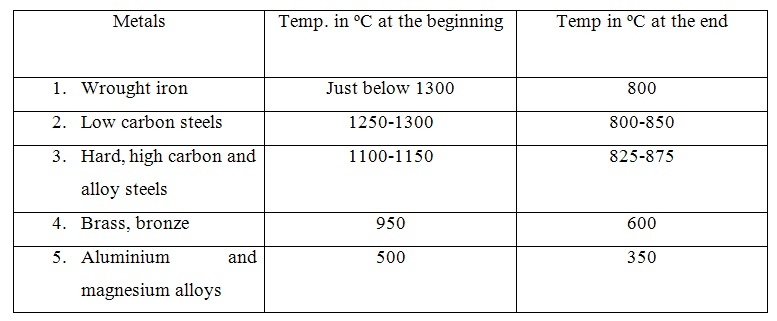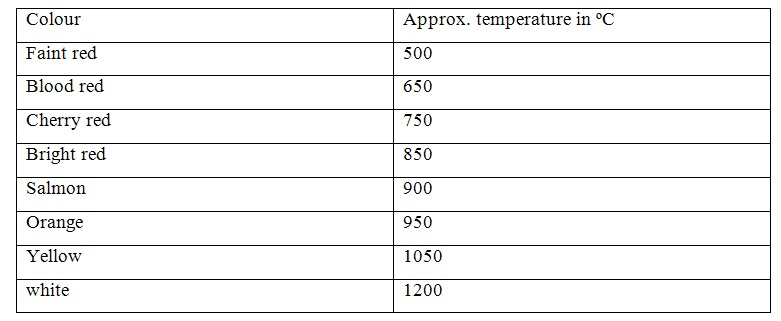Site pages
Current course
Participants
General
20 February - 26 February
27 February - 5 March
6 March - 12 March
13 March - 19 March
20 March - 26 March
27 March - 2 April
3 April - 9 April
10 April - 16 April
17 April - 23 April
24 April - 30 April
Lesson 5. SMITHY AND FORGING OPERATION
Module 3. Smithy and forging tools and operation
SMITHY AND FORGING OPERATION
5.1 Fuels Used in Furnaces
Many types of fuels are used in the furnace employed in forging work. All these fuels can be broadly classified into three groups, as follows:
1. Solid fuels – such as coal, coke, charcoal etc.
2. Liquid fuel – they include different types of fuel oils.
3. Gaseous fuels – natural gas and producer gas.
5.2 Forging Materials
The materials possessing the ability to sustain substantial plastic deformation without fracture even in presence often sile stresses can be forged easily. Wrougt iron, low and medium carbon steels, low alloy steels, aluminium, magnesium and copper alloys are common forgeable materials. Austenite and marten site stainless steels, nickel alloys can be forged with some difficulty.
5.3 Forging Temperatures

The temperature of heating steel for hand forging can be estimated by the heat colour of the heated steel are given in the following table :

5.4 Forging Operations
For giving desired shapes to the products the following operations are used in a smithy shop.
1. Upsetting
2. Drawing out or drawing down.
3. Cutting
4. Bending.
5. Punching and drifting.
6. Setting down and finishing.
5.4.1 Upsetting or Jumping
- Upsetting is the process through which the cross-section of a metal piece is increased with a corresponding reduction in its length.
- When a metal is sufficiently heated, so that it acquires the plastic stage, it becomes soft.
- If some pressure is applied to it the metal tends to increase in its dimensions at right angles to the direction of application of force with a corresponding reduction in its dimensions parallel to the line of action of the said force.
- The particular aprt in the bar shape, where said increase in the cross-section is desired, is heated till it acquires a fully plastic state.
Hammering in this operation is done either by the smith himself, if the job is small, by means of a hand hammer or by his helper in case of big jobs, when heavy blows are needed, by means of a sledge hammer.
5.4.2 Drawing out
This process is also known as drawing down. It is exactly a reverse process to that of upsetting in the sense, it is employed when a reduction in thickness, width or both of a bar is desired with a corresponding increase in its length. The desired effect is possible to be obtained by the use of either the peen of a cross peen hammer, a set of fullers or a pair of swages (for round bars only).
The process of heating and cooling the length, not required to be drawn, is the same as in case of upsetting, but the selection of the above tools is governed by the shape of the cross-section of the stock, the amount by which the increase in length is desired and also the required finished shape of the job.
5.4.3 Cutting
- Cutting of metals in hot or cold state is done by means of hot or cold chisels respectively.
- This operation is required in removing extra metal from the job before finishing it, cutting required lengths of pieces from a stock, splitting a metal piece into two at a desired location and similar other requirements.
- Enough care should be taken while cutting cold steel, since there is every likelihood of the chips flying off in different directions and cause injuries.
- Also, more power and time is taken in cold cutting as compared to hot chiseling.
- If very thick section is being cut, even cracks may sometimes occur. Cold cutting is, therefore, preferred for the thin sections only, such as rods of thin sections and sheets, etc., (usually below 20 mm thickness).
- Especially alloy steels should never be cut cold.
- For hot cutting of steel, it should be heated to red heat in the furnace and then cut. The usual temperature for hot cutting is 850 0C to 950 0C.
Bending of bars, flats and other similar stock material is usually done in a smithy shop. This can be done to produce different types of bent shapes such as angles, ovals and circles, etc.
Any desired angle can be made through this operation. For making a right angle bend that particular portion of the stock, which is to be subjected to bending, is heated and jumped on the outer surface.
This operation is carried out on the edge of the anvil or on the perfectly square edge of a rectangular block. After bending, the outside bulging is finished by means of a flatter and the inside one by means of a set hammer.
Curved shapes of bends are formed on the horn of the anvil. For mass production of articles made through bending, particularly when dimensional accuracy is a must, jigs and fixtures are designed to help in performing this operation quickly and efficiently. This results in a considerable saving of time and labour.
5.4.5 Punching and drifting
Punching and drifting are used for producing and finishing holes and preparatory for producing other shapes.Punching should be done in two stages. In the first stage the work piece is kept flat on the anvil and holes performed half way through. Then job is turned upside down. The application of punching, producing the slot a number of holes are punched and the remaining excess material is cut out using a chisel. The slot may then be finished hot drifting or may be finished by filing when cold.
5.4.6 Setting down
It is a localized drawing down or swaging operation. Usually the work is fullered at the place where the setting down is effected by the set hammer.
5.5 Forging Processes
The processes of reducing a metal billet between flat dies or in closed impression dies to obtain a part of predetermine size and shape are smith forging and impression die forging respectively.Depending on the equipments utilized they are further sub-divided as under.
5.5.1 Smith die forging
It is also known as flat die or open die forging. It is simple,relatively inexpensive and allows the production of large verities of shapes.The final shape of the forging depends largely on the skill of the smith.
A. Hand forging: Hand forging is employed only to shape a small number of light forgings mainly in repair shops. This is done by hammering the piece of metal, when it is heated to proper temperature, on an anvil. A hand hammer or a sledge hammer is used for striking.
B. Power forging: Large machine parts which cannot be forged by hand forging, use of power hammers and presses is employed to do the job.
i. Hammer forging: machines which work on forging by blow are called hammers. The heavy falling part of the hammer is called the ram and the rigid support is in the form of anvil block. The power hammer may be a gravity fall type or a higher striking velocity type such as mechanical hammer,air and steam hammer etc. these hammers are available with different ram weight and different blows rate per minute.
Press forging: Forging presses for smithy work are usually of the hydraulic type. In press forging, pressure or squeeze is applied to the raw material and intensity of this pressure increase as the plastic metal resists deformation. As the pressure applied squeezes the metal slowly compared to blow hammer, more time is available for the flow of metal being forged.
5.5.2 Impression die forging
It is employed for more complex shapes of greater accuracy, large quantities of identical forgings as well as for special items with quality and economy reasons.
a) Drop forging: Three types of drop hammers are used in making drop forgings. They are board or gravity type, air lift hammer and power drop hammer also, called steam hammer.
b) Press forging: It is done in presses rather than with hammers. The action is relatively slow squeezing instead of delivering heavy blows. This allows the gases to escape from the forging.